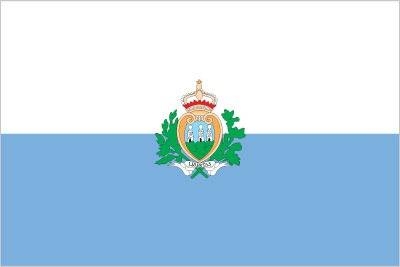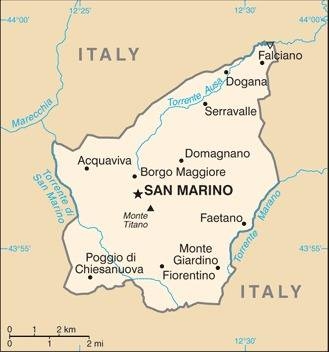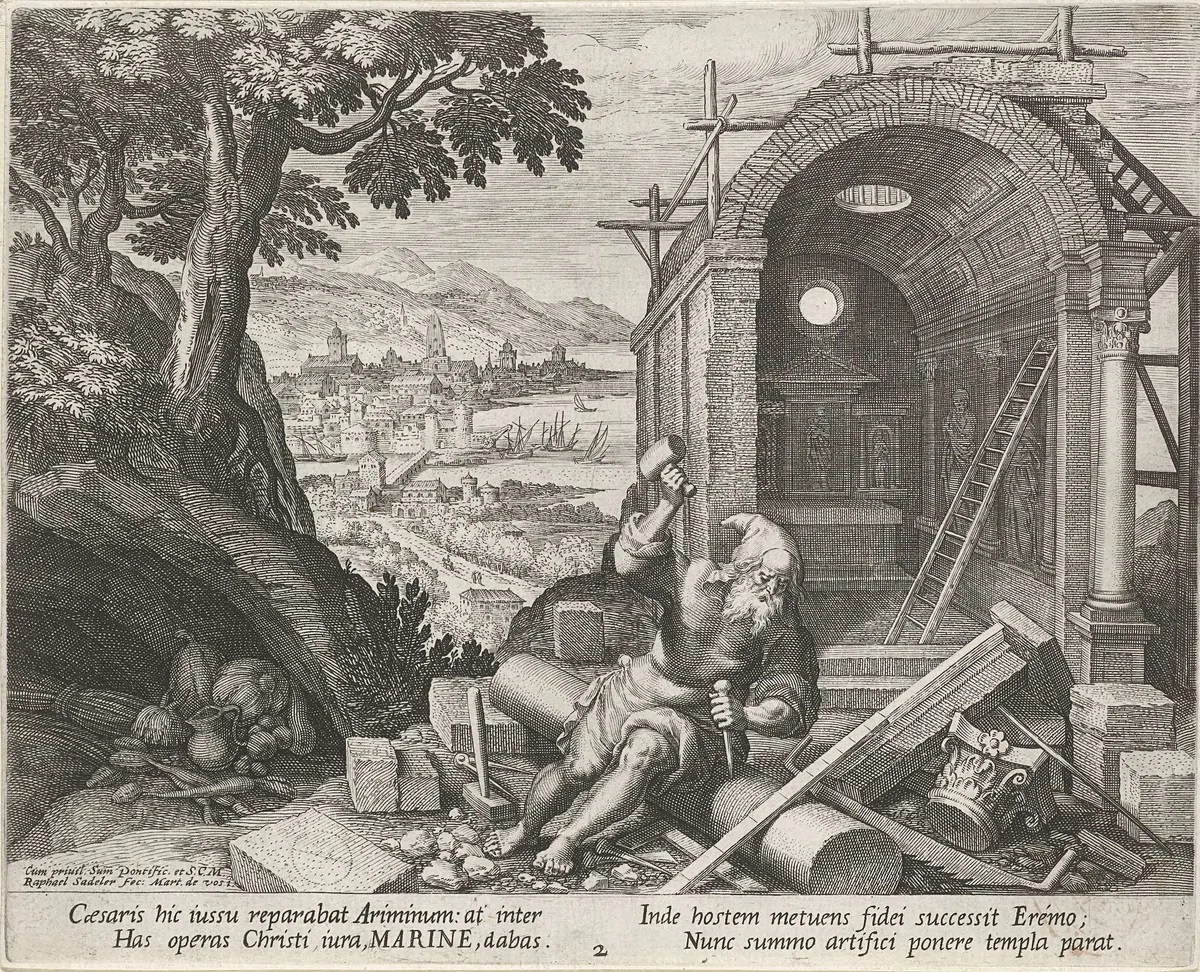106 San Marino

Two equal horizontal bands of white (top) and light blue with the national coat of arms superimposed in the center. The main colors derive from the shield of the coat of arms, which features three white towers on three peaks on a blue field. The towers represent three castles built on San Marino’s highest feature, Mount Titano: Guaita, Cesta, and Montale. The coat of arms is flanked by a wreath, below a crown and above a scroll bearing the word LIBERTAS (Liberty). The white and blue colors are also said to stand for peace and liberty respectively.
Flag courtesy of the CIA World Factbook

Map courtesy of the CIA World Factbook

Illustration of Saint Marinus, the founder of the Republic of San Marino and prominent cultural figure
Government
According to Britannica, the San Marino constitution, originating from the Statutes of 1600, provides for a parliamentary form of government. The Great and General Council (Parliament) has 60 members, elected every five years by all adult citizens. It has legislative and administrative powers and every six months nominates the two captains regent (capitani reggenti), who hold office for that period and may not be elected again until three years have elapsed. The Great and General Council is headed by the captains regent, who are heads of state and of the administration. The Congress of State, a council of ministers, is composed of 10 members, elected by the Great and General Council from among its members, and constitutes the central organ of executive power. Each member has charge of a ministerial department.
Civil Aviation Authority (CAA)
The Republic of San Marino is a member State of the International Civil Aviation Organization (ICAO) since 1988, a specialized agency of the United Nations, created in 1944 to promote the safe and orderly development of international civil aviation throughout the world. It sets standards and regulations necessary for aviation safety, security, efficiency and regularity, as well as for aviation environmental protection.
The primary aviation legislation consists of Law No. 87 (the Civil Aviation Law) of 30 October 1992; Law No. 9 established the CAA as an autonomous entity responsible for all technical matters related to civil aviation, in particular the promulgation of regulations in its area of competence. Decree No. 73 contains most of the basic provisions related to civil aviation and consists of thirty-eight articles, grouped in seven titles, namely: General provisions, Aviation Register, Air Navigation, Production, Commercial services, Aircraft accidents, International Law and final provisions.
Airspace
SkyVector – Google Maps – ADS-B Exchange
ICAO countries publish an Aeronautical Information Publication (AIP). This document is divided into three parts: General (GEN), En Route (ENR) and Aerodromes (AD). ENR 1.4 details the types of airspace classes they chose to adopt from classes A through G.
Agreement with Italy – see Italy AIP – COOPERATION AGREEMENT between THE CIVIL AVIATION AND MARITIME NAVIGATION AUTHORITY of the Republic of San Marino and THE NATIONAL CIVIL AVIATION AUTHORITY of the Italian Republic
Drone Regulations
CAR OPS 4 – Remotely Piloted Aircraft Systems (RPAS) Operations
Advanced Air Mobility (AAM) Regulations & Policies
None found by the author.
However, should you, the reader, happen to stumble across something to the contrary, please email the author at FISHE5CA@erau.edu and you may be mentioned in the ACKNOWLEDGEMENTS section of this book by way of thanks for contributing to this free eBook!
Advanced Air Mobility (AAM) News
None found by the author.
However, should you, the reader, happen to stumble across something to the contrary, please email the author at FISHE5CA@erau.edu and you may be mentioned in the ACKNOWLEDGEMENTS section of this book by way of thanks for contributing to this free eBook!
Short Essay Questions
Scenario-Based Question
You have been hired by a Drone Startup Company. Your boss has immediately assigned this job to you.
They need you to prepare a one-page memo detailing the legalities of using a drone to film in San Marino.
They need you to mention any national laws and local ordinances.
They specifically want to know what airspace (insert pictures) you will be operating in and whether or not you need an airspace authorization.
Does it matter whether or not you are a citizen of the country?
Lastly, there is a bonus for you if, as you scroll through this chapter, you find any typos or broken links!
Short Essay Questions
- What are the drone categories?
- How is registration addressed?
- How is remote ID addressed?
- What are the model aircraft rules?
- What are the commercial drone rules?
- Are there waivers or exemptions to the rules? If so, for what?
- Would you share a link to an interactive airspace map?
- How is BVLOS addressed?
- How can you fly drones at night?
- How can you fly drones over people?
- Where do you find drone NOTAMs?
- What are the rules for drone maintenance?
- What are the rules for an SMS program?
- What are some unique rules not mentioned above?
- What are the C-UAS rules?
- What are the AAM rules?

